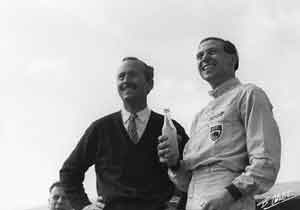People
Colin Chapman

The son of a hotel manager, Chapman grew up in Hornsey and studied mechanical engineering at University College, London. He was an enthusiastic member of the University Air Squadron and learned to fly while still a student. He then did his national service as a Royal Air Force pilot in 1948. After he left the RAF Chapman bought and sold secondhand cars while becoming a member of the 750 Motor Club, which was the nursery for many of the top F1 engineers of the 1960s and 1970s. Chapman's first car was a special built using a 1930 Austin Seven and this was entered in a series of trials. It was called a Lotus because Chapman and his friends had worn themselves out building it and they reckoned it had the same soporific effect as the lotus flower. The car was a success and Chapman built further examples although he was by then working at the British Aluminium Company. In 1952 his girlfriend Hazel Williams lent him £25 to establish the Lotus Engineering Company with Michael Allen, with the aim of building copies of his racing machines. In 1953 Frank Costin joined the company from De Havilland and the Lotus Mk 8 enjoyed some success. This enabled Chapman to quit BAC and concentrate full-time on Lotus, producing racing cars and roadgoing machines in workshops which had been set up in old stables behind the Railway Hotel in Hornsey, where his father was the manager. At the same time Chapman did consultancy work for the Vanwall and BRM racing teams. Increasing success with the sportscars led Chapman to build his first single-seater racing car in 1956. The Formula 2 - designed the Lotus 12 - enjoyed some success in 1957. As the Coventry Climax engines were stretched so Chapman decided to enter Grand Prix racing, running a pair of Lotus 12s at Monaco in 1958 for Graham Hill and Cliff Allison. These were replaced later that year by Lotus 16s. Having achieved little in 1958 and 1959 Chapman switched to rear-engined cars in 1960 with the Lotus 18. By then the company had expanded to such an extent that it had to move to new premises in Cheshunt. The first victory in a Lotus car came at Monaco in 1960 when Stirling Moss beat the dominant Ferrari team in his Rob Walker Lotus. The first victory for Team Lotus itself was at the end of the following year when Innes Ireland won the United States Grand Prix. There were other successes in Formula 2 and Formula Junior. The road car business was also doing well with the Lotus Seven and the Lotus Elite and this was followed by the Lotus Elan in 1962 and the Lotus Cortina in 1963. Success on the race track was an important part of the company's success and in 1963 Jim Clark drove the Lotus 25 to a remarkable seven wins in a season, winning the World Championship. The team was beaten at the last race in 1964 but in 1965 Clark dominated again. For the new 3-liter Formula 1 in 1966 Chapman chose BRM engines (a mistake) but the arrival of the Cosworth DFV in 1967 returned the team to winning ways with Graham Hill World Champion in 1968 with the Lotus 49. In 1970 Jochen Rindt was posthumous World Champion with the Lotus 72 and Emerson Fittipaldi used a revised version of the car to win Lotus another World Championship in 1972. The company had moved from Cheshunt to Ketteringham Hall in Norfolk in 1966 and continued to do well financially as the demand for sportscars in the 1960s seemed to be endless. Chapman was also successful at Indianapolis with the Lotus 29 almost winning the 500 at its first attempt in 1963 with Clark. The race marked the beginning of the end for the old front-engined Indianapolis roadsters. Clark was leading when he retired from the 1964 event but in 1965 he won the biggest prize in US racing. Many of Chapman's successes came from innovation. The Lotus 25 was the first monocoque chassis in F1, the 49 was the first car of note to use the engine as a stressed member and the 72 broke new ground in aerodynamics. Chapman was also an innovator as a team boss and it was Team Lotus which first introduced commercial sponsorship to F1 at Monaco in 1968. In the mid-1970s, however, Lotus engineers began to investigate aerodynamic ground-effect and the Lotus 79 of 1978 was extraordinarily successful with Mario Andretti winning the World Championship. Chapman was beginning work on an active-suspension development program when he died of a heart attack in December 1982 at the age of only 54. It was probably fortunate that he died when he did and thus avoided the scandal which was later revealed about Lotus's involvement with the Delorean car company. A judge later remarked that if Chapman had been alive he would have been sent to jail for 10 years for an "outrageous and massive fraud".